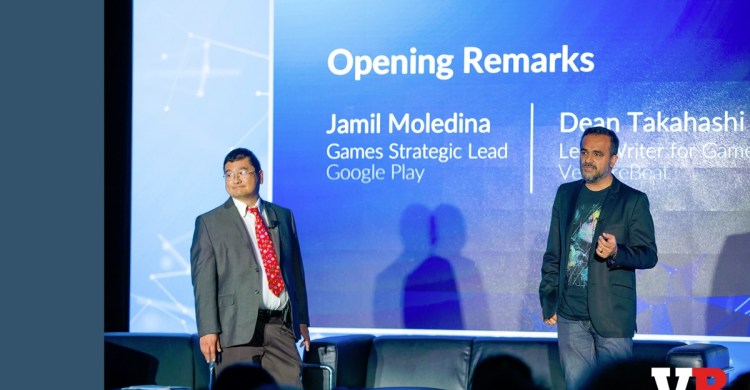We just hosted our third annual GamesBeat Summit at the Claremont Hotel in Berkeley, Calif. It was a beautiful place and a great backdrop for our talks about the inspiration cycle between science fiction, real-world technology, and games. We had 72 speakers and 250 attendees with endless stories to tell, but here’s some of the beautiful threads that stood out for me.
Making the Metaverse
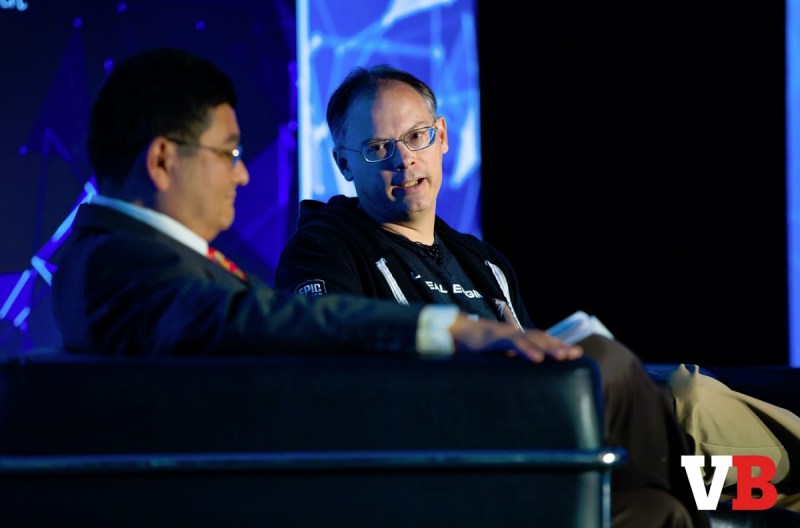
Above: Tim Sweeney, CEO of Epic Games, wants the Metaverse to happen.
We kicked off the conference with Tim Sweeney, CEO of Epic Games. I asked him where we were in our ability to create the Metaverse, the immersive virtual world envisioned by sci-fi novelist Neal Stephenson in Snow Crash. Sweeney said that social VR experiences like Altspace VR and Facebook’s social VR platforms are the beginning of the Metaverse, but we still need technologies like “deep input,” or taking videos of people’s faces (and capturing their emotions) and transporting that into a virtual environment.
He said the tech can work in commercial hardware that costs tens of thousands of dollars, but he said it might just be about two VR hardware generations, or as little as three years, before we will have the inward and outward facing cameras to capture our expressions, image recognition, and face recognition technology to make the experience much more immersive.
Artificial intelligence and believable human graphics will contribute to the Metaverse’s realism, and that will open a whole new genre of games about making human connections rather than killing monsters. Sweeney also thinks it will also be a few short years before we can make augmented reality glasses with 8K resolution per eye, where it animations will fully blend with reality.
Sweeney sees massive amounts of investment happening in China and South Korea toward VR, and that could very well lead to making the Metaverse. But Sweeney is worried not only about our ability to keep the Windows PC open, but also about the ability to keep the Metaverse from being taken over by corporate interests with proprietary technologies.
“That’s the central question for the industry, and something I think about a lot,” Sweeney said. “The web was open because it was built on standards. It’s the opposite of Twitter and Facebook, which are locked down proprietary APIs and services controlled by companies. If we build the Metaverse based on top of protocols and all the major players in the industry are committed, we can avoid any one company taking control and having a monopoly over not just commerce. That’s bad enough, but a monopoly over our private data.”
The future of augmented reality

Above: Dean Takahashi (left), Ralph Osterhout, John Underkoffler, and John Hanke at GamesBeat Summit.
I like how Sweeney thinks ahead and thinks things through. That’s how I also felt about our panel on the future of augmented reality, which included speakers Pokémon Go (the first mass market AR app?) co-creator John Hanke of Niantic Labs; Minority Report science adviser and Oblong Industries CEO John Underkoffler; and AR glasses maker and Osterhout Design Group CEO Ralph Osterhout.
All three of them said they were die-hard sci-fi fans. They represented applications, user interface, and hardware perspectives on AR. I asked them if it was hard to create AR today — with bulky hardware and flawed software — when they have such visions of the perfect state of AR or VR in their minds.
Hanke said, “It’s great to have those visions of what it can be to carry us through those periods of when it is not quite there. Hollywood gave us “Hal” in [2001: A Space Odyssey] in the 1970s and we got the TRS-80. It wasn’t quite Hal, and it took us another 30-plus years to get to what Hollywood promised us. It’s going to get better. It’s going to get there. Every new consumer electronics technology has sucked for the first five years on the market. VR is going through that. AR is going through that. We are all going to wear smart glasses on our faces. I have no doubt about that.”
“Virtually every person I’ve met [wants a Star Trek] Holodeck,” Osterhout said. “The Holodeck that I see going forward is that where I look anywhere I choose to and [can see things coming out of the sidewalk], and the capability is here.”
Underkoffler said, “We do have a vocabulary problem of what is VR and AR. Sometimes the hardware is a limitation. Sometimes the experience takes an important leap,” like Pokémon Go did using existing smartphone technology. Hanke pointed to Nintendo, which has always made great gameplay experiences using hardware that could be made from commodity parts, with a lot of constraints.
It may take a while to get to a pair of $200 AR glasses that do everything you want them to do.
Osterhout said, “[The tech] exists. But there’s no such thing as a free lunch. You don’t get to jam in another screen from a high-end smartphone into a tiny device and say, ‘I want that son-of-a-bitch for free!’ Everybody wants to have a Ferrari. But the sheer fact of the matter is if you’re driving a Prius, you’re not gonna be able to do everything that the Ferrari can do.”
I asked Hanke to speculate about what Pokémon Go 10 would look like.
“Well, I think those [pocket] monsters are gonna feel really real to you. I think they’re gonna be with you,” said Hanke. “I think you’re gonna be friends with them. Your kids are gonna have them in the house and they’re gonna be like pets. … It’ll be a fun journey getting there.”
Hollywood envy
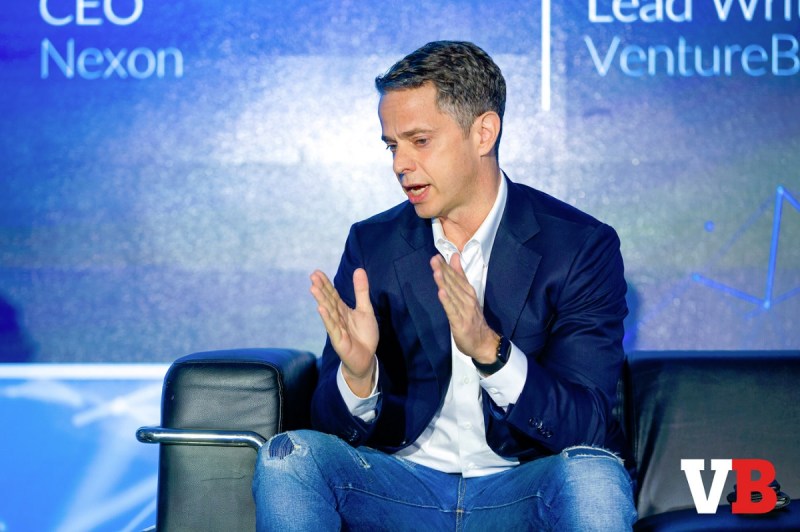
Above: Owen Mahoney, CEO of Nexon, at GamesBeat Summit 2017.
Part of the premise of our theme was that industries can learn from each other. But not everybody was on board with that part of our theme, which suggested that you can really learn something from other industries. But that’s OK, because diversity of viewpoints is a healthy thing. We all need our Klingons, our speaker suggested.
Owen Mahoney, CEO of Nexon, was wedged in between virtual reality speakers like Sweeney, Kim Pallister, and Austin Grossman and Gary Whitta of Hollywood on the other. Mahoney let us know that he didn’t think VR was worth spending a lot of money on yet, and he also said that admiring Hollywood could be the wrong thing to do for game developers.
“Hollywood is based on a linear form of entertainment, where you write a story, do principal photography, and do preproduction because that photography is so expensive, and then you do post production,” said Mahoney. “The game industry is nothing like that, and yet we use the movie vocabulary. There’s no producer in the game industry that does the same thing as a movie producer. We use the nomenclature of the movie industry, but games that move the industry forward are some planning, some coding, and some testing. Then you find out what is broken. That’s a loop of iteration on how you make a great game.”
Games are systems that set up decisions for the player, and the player creates the story and the ending from their own point of view, Mahoney said. With such different businesses, Mahoney thinks that Hollywood envy is wrong. After all, Nexon’s Dungeon Fighter game has generated more than $8 billion in revenues in a decade, compared to $7.5 billion for Star Wars movies at the box office.
“I find games to be the most interesting form of art,” Mahoney said. “If we look for inspiration, we should look at how interesting systems and decisions are. If we focus on that, instead of whatever is coming out from Hollywood this month, we would have much healthier game industry.”
How games saved Star Wars
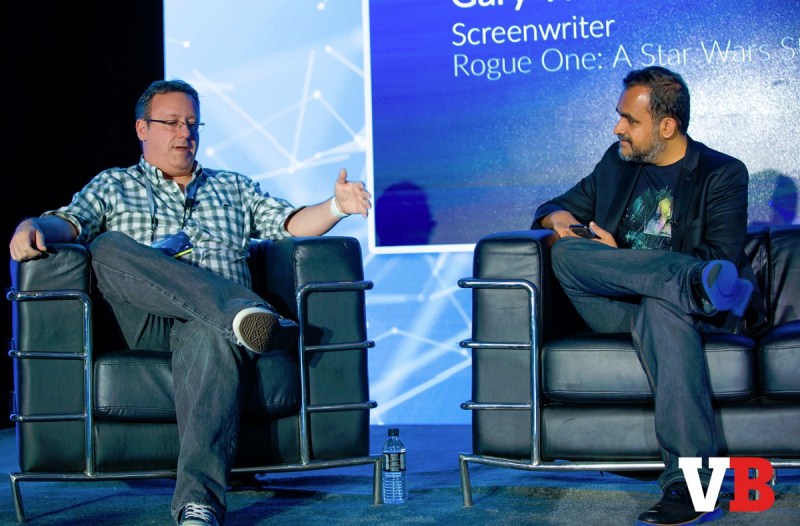
Above: Gary Whitta (left) and Jamil Moledina at GamesBeat Summit.
Even Gary Whitta, the screenwriter for the blockbuster film Rogue One: A Star Wars Story, said in an interview with Jamil Moledina of Google that games have carried the flag of creativity. He noted that after George Lucas finished his first six films, he stopped doing a lot with that universe. And games had to carry Star Wars forward for many years, keeping it alive until Disney came along and acquired Lucasfilm.
“Star Wars was in a wilderness, and there was a pretty long time where video games were at the vanguard of what Star Wars was,” Whitta said. “Video games carried that burden and kept Stars Wars alive in our imaginations for a very long time.”
Whitta grew up wanting to escape, and he didn’t care if films or games or novels or comic books were different.
“I scratched an itch, and I found that video games scratched the itch better than most because they invited me in,” he said. “You talk about immersion. When the lights go down in a game, you cross into that plane in your mind in a much more real way. It was a more effective way to escape than almost any other medium where science fiction could exist.”
Whitta said he appreciates indie games and the ability to experiment more than Triple-A games, which have become conservative akin to major Hollywood releases.
Call of Duty is creative?
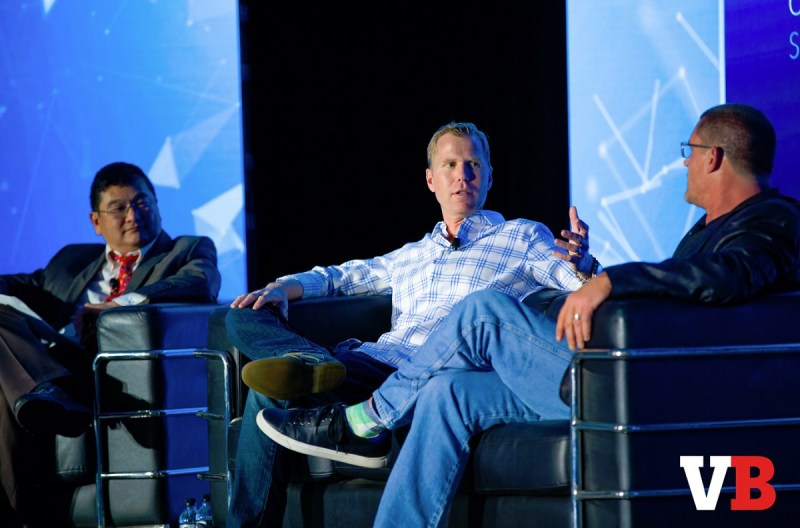
Above: Dean Takahashi (left), Michael Condrey, and Glen Schofield at GamesBeat Summit.
The conference wasn’t just about science fiction. Our larger theme was about inspiring creativity. And we heard a very inspirational, passionate presentation of Call of Duty creators Michael Condrey and Glen Schofield of Sledgehammer Games. They’re tasked with being creative at making a new version of a game that has had 15 installments. And they took the franchise back to its roots in World War II and figured out how they could tell a much more emotional story and riveting experience with modern game technology.
Sledgehammer took a huge turn away from the future, with its Call of Duty: Advanced Warfare sci-fi title, and went in a very different direction with the Second World War. They traveled the battlegrounds of Europe to get the research they needed to make an authentic World War II experience. And they made it happen because both of the founders were aligned with their passion to take Call of Duty back into the past. They bristle at the notion that Call of Duty games can’t be creative.
“This is a deep, deep dive into what did happen,” Schofield said. “I’m an artist. My whole life. I paint. I draw. I have paint on my hands now. This is art. The story of the characters is ours. Creatively, it is like saying to [filmmaker Steven Spielberg] Saving Private Ryan wasn’t creative because it was just a war movie.”

Above: Flamethrower in Call of Duty: WWII
Condrey said, “I look at franchises that are beloved throughout time. There are inflection points where new creative visions come in. The Dark Knight was a great moment in Batman history. Three years is a long time to devote to anything. No one wants to put three years of their lives on hold for game that is not creative.”
All of the research and dedication has made the game more authentic, and given the creators more respect for the sacrifice of the heroes of the war. And they came to respect the diversity of those who did the fighting.
“It was a World War. Every person, every country was touched by it. There wasn’t any group that was spared by it. In Paris, you have the French Resistance, and many were made up of women. In the U.S., the African American troops were indispensable. We don’t hide the racism. One of the guys in the platoon is Jewish,” Schofield said. “We’re just trying to tell the truth.”
“I remember this emotional journey I went on,” Condrey said. “Ten years ago, all the heroes were alive and they could be interviewed. We started this journey saying we want to tell this story because we couldn’t let this drift from memory and make sure it never happens again. And we also realized that the people who were fighting for our freedom were no longer able to tell it themselves. That whole crew is no longer around. These common men and women who did these uncommon things can’t tell the stories for themselves.”
Schofield said, “It’s really personal for most of us on the team. My grandfather lost his leg and got a Purple Heart. He would tell these stories. And my dad died during this game and we named the main character after him. In the end, we’ve all gotten respect and listening to their stories. We’re trying to get everything right.”
I teared up a number of times during these talks about passion and creativity, and that made it more universal to me than just sci-fi. I’ve got many more talks to summarize and comment upon, but this will do for today. I was inspired by the imaginations of these speakers and where they ran with our theme, and I’m so happy that they chose GamesBeat Summit as a place to share their wisdom. Thanks to all who spoke and those who came or watched the streams. We’ll have videos of these talks soon.
